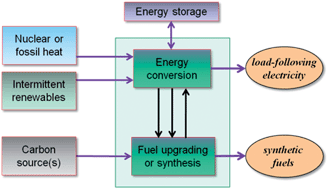Hybrid energy systems using nuclear heat sources can economically produce load-following electrical power by exploiting their surplus generation capacity, available at night or seasonally, to make synthetic fuel. Vehicle fuel is the only current energy use large enough to absorb all the energy capacity that might be diverted from the power industry, and its ease of storage obviates problems with discontinuous synfuel production. The potential benefits and challenges of synfuels integration are illustrated by the production of methanol from natural gas (as a source of carbon) using steam from a light water nuclear power reactor which is assumed to be available in accord with a year's worth of power demand data. The synthesis of methanol is easily adapted to using 300 °C heat from a light water reactor and this simple compound can be further processed into gasoline, biodiesel (to esterify vegetable oils), or dimethyl ether, fuels which can be used with the current vehicle fleet. A supplemental feed to the methanol process of natural gas (for energy) allows operation at constant full rate when the nuclear heat is being used to produce electrical power. The higher capital costs of such a system are offset by a lower cost of heat and power production from a large base load type of plant and by reduced costs associated with much lower CO2 emissions. Other less tangible economic benefits of this and similar hybrid systems include better use of natural resources for fuels and greater energy supply reliability from the domestic production of vehicle fuel.

You have access to this article
 Please wait while we load your content...
Something went wrong. Try again?
Please wait while we load your content...
Something went wrong. Try again?


 Please wait while we load your content...
Please wait while we load your content...